ARCI has been studying Short-tailed Hawks, one of Florida’s rarest raptors, since 1999. These stunning raptors are sometimes overlooked because of their secretive behaviors. They hunt from high in the sky, often disguising themselves in a kettle of vultures before diving down to surprise avian prey. They like to nest in forested strands often associated with water; however, they have recently been nesting in more urban settings, perhaps to take advantage of often-abundant small birds on which they prey.
Why do we study Short-tailed Hawks? Well, the species has no state or federal listing status and no monitoring program exists. In addition to their very small population size (last estimated at 250 pairs in the United States, almost all in Florida), several factors place Short-tailed Hawks at risk: a preference for nesting in large tracts of mature forest, the accelerating loss of historic nesting territories, concentrated winter distribution, specialized diet, and unusually low nesting success.
Bird by bird and nest by nest, we are gathering that information to answer these basic important questions and to help ensure that Short-tailed Hawks will persist into Florida’s future. See our website for more information on ARCI’s Short-tailed Hawk research.
For the last two years, we have been collaborating with the St. Petersburg Audubon Society as part of their “Raptors on the Move” program, which is directed by Dr. Gabe Vargo. In our first year, we tagged an adult female Swallow-tailed Kite, Sawgrass, with a GPS/GSM transmitter (GPS locations are sent to us via cell phone networks) and have been watching her migrate to Bolivia and back over the last 18 months.
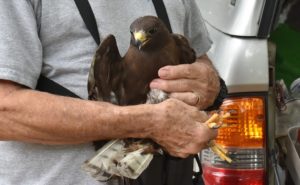 |
| Dr. Gabe Vargo, director of St. Peterburg Audubon Society’s “Raptors on the Move” program, holds Dark Arrow. Photo by JoAnna Clayton, 2017. |
In July 2016, knowing there was an active Short-tailed Hawk nesting territory at Sawgrass Lake Park in Pinellas County, Florida, we began trying to capture and tag an adult Short-tailed Hawk to add to “Raptors on the Move”. After many trapping attempts with various methods that spanned 10 months, we FINALLY succeeded when a beautiful dark-morph adult flew into our net on 23 May 2017. We’ve named this bird – most likely a male based on its size – “Dark Arrow” because “Dark” is its color morph, and “Arrow” is the name of the lake closest to the capture site in Sawgrass Lake Park.
Dark Arrow spent the rest of the summer at Sawgrass Lake Park, where he and his dark-morph mate fledged a dark morph juvenile. Many of its foraging destinations lie about 4.5 miles east of the Weedon Island Preserve.
When the winds picked up with oncoming Hurricane Irma, Dark Arrow returned to Sawgrass Lake Park to sit it out in a more densely forested location away from the coast. This hawk’s tracking data suggest he was restless through the stormy night, apparently moving from one wind-tossed tree to another, possibly looking for stronger branches on which to perch in the 70 mph wind gusts.
Dark Arrow is now back in his familiar nest-season surroundings, between Weedon Island Preserve and Sawgrass Lake Park. We are curious to see what he will do for the rest of the winter. Will he migrate to south Florida as do many Short-tailed Hawks, or will he stay in Pinellas County? Short-tailed Hawks are seen throughout the year at Sawgrass Lake Park, but most undergo a true migration within the state of Florida for the winter months. Because there is a plethora of urban birds to feed on year-round in the county and nesting conditions there appear to be ideal, he may stay put to maintain ownership of his territory. Only time will tell. We will share the tracking data with you as it accumulates.

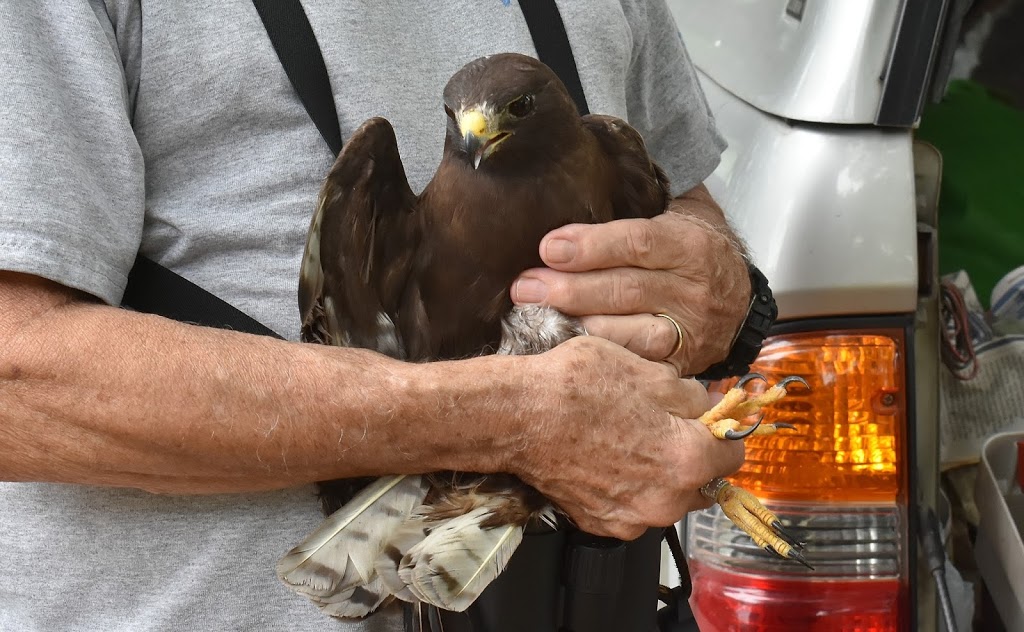
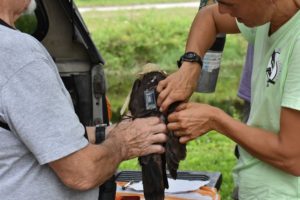
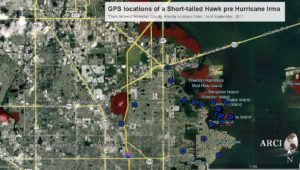
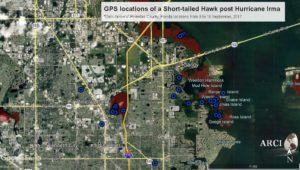
I’m pretty sure there was a pair of Short-Tailed Hawks following me around while I was mowing, today. Large grasshoppers/katydids would take flight and these birds would swoop from their branch and catch them mid-flight–or miss altogether. They followed me from one side of the yard to the other, changing trees as I moved around. I have been mowing my lawn, here, for 33 years and never had seen this. It happened a dozen plus times, today.
I live in Crawfordville, Fl. Wakulla County. 32327
I’m very happy the short-tails are being studied. I live in Key West and see a variety of raptors daily; however, these are the most frequent hawks, as I observe them daily for more than half the year – less frequent in summer. I have a “higher perch” than they do out in the Saltpond mangrove forest, so I have a unique perspective and lots of free time. I have hundreds of (telephoto ) photos from all angles, perched and in flight. They roost here at least every other night, often in their favorite spots, and especially one particular dark morph; however, I’ve seen both morphs and mixed pairs. I’m very familiar with their daily habits, perch routines, etc. and find it interesting they have never once taken prey from their roosting area (loaded with their favorites). I have a lot of data and photos, so I will check the website to see if I can contribute something if use.